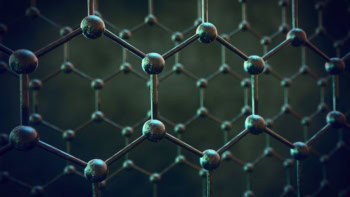
The “wonder material” graphene has another significant quality to add to its impressive list of electrical and mechanical properties: superconductivity. Physicists in Canada and Germany have shown that graphene turns into a superconductor when doped with lithium atoms – a result that could lead to a new generation of superconducting nanoscale devices.
Graphene exhibits a range of remarkable properties, thanks to its special structure – a one-atom-thick hexagonal lattice of carbon atoms. It is far stronger than steel while also flexible, and is an excellent conductor of both electricity and heat. In its pristine form, however, it is not a superconductor.
Coupling Cooper pairs
Neither is pure graphite, but in 2005 physicists showed that graphite could be made to superconduct when chemically treated, so as to create bulk materials consisting of graphene alternated with one-atom-thick layers of another element. The best performing material thus created, calcium graphite (CaC6), has a superconducting transition temperature of 11.5 K. Theorists identified the underlying mechanism for that superconductivity as electron–phonon coupling. Phonons are vibrations in a material’s crystal lattice that bind electrons together into “Cooper pairs” that can travel through the lattice without resistance – one of the hallmarks of superconductivity. It was then realized that such electron–phonon coupling might occur not just in bulk graphite compounds but also by depositing atoms of a suitable element on to single layers of graphene.
In 2012 Gianni Profeta of the University of L’Aquila in Italy and colleagues used computer modelling to predict that lithium ought to be a particularly good candidate for such doping. This came as a surprise, given that bulk LiC6 had not been shown to superconduct, but the researchers nevertheless found that the monolayer structure should promote superconductivity in two ways. The additional lattice vibrations generated by the lithium atoms should yield a high density of phonons, they said, while lithium’s donation of electrons to the graphene should strengthen overall electron–phonon coupling.
Lithium decorations
That prediction has been borne out by the latest work, which has been carried out by Andrea Damascelli at the University of British Colombia in Vancouver, together with colleagues in Europe. Damascelli and co-workers prepared their samples by growing layers of graphene on silicon-carbide substrates, and then very precisely depositing lithium atoms onto the graphene – a process known as “decorating” – in a vacuum at 8 K.
The team then studied the properties of the samples using angle-resolved photoemission spectroscopy, which exploits the photoelectric effect to measure the momentum and kinetic energy of electrons in a solid. The researchers found that the electrons were being slowed down as they travelled through the lattice, an effect that they attributed to enhanced electron–phonon coupling. Crucially, they also showed that this greater coupling leads to superconductivity by identifying an energy gap between the material’s conducting and non-conducting electrons – which is the energy needed to break Cooper pairs. At 0.9 meV, the measured value of this gap implies a transition temperature of about 5.9 K – as compared with Profeta and colleagues’ prediction of up to about 8 K.
Further checks
According to Damascelli, this result enhances graphene’s utility as model system for studying quantum phenomena, as well as showing how a wide range of electronic devices could be connected to one another via a single substrate. Indeed, Patrick Kirchmann and Shuolong Yang of the SLAC National Accelerator Laboratory in California, who were part of a group that last year demonstrated the phonon basis of CaC6 superconductivity, believe the work might eventually lead to the production of nanometre-sized superconducting quantum interference devices and single-electron superconductor quantum dots, for example. They add, however, that the result must first be confirmed, via the observation of two additional effects: graphene’s complete loss of electrical resistance and its expulsion of external magnetic fields – the Meissner effect – when cooled below the transition temperature. These measurements, says Kirchmann, “are needed to confirm superconductivity and pin down the transition temperature”.
Damascelli says that carrying out these measurements will require a new way of preparing the decorated graphene – one that allows the material to remain stable at ambient conditions while exhibiting macroscopic superconductivity. “We are looking at different elements,” he says, “and at different substrate–graphene combined systems that could aid the retention of the decorating atoms.”
A separate group of researchers, including Hyoyoung Lee, Tuson Park and colleagues at Sungkyunkwan University in South Korea have observed superconductivity in samples consisting of several layers of graphene doped with lithium. The group records a transition temperature of 7.4 K, obtained via observation of the Meissner effect.
“The next milestone would be to demonstrate this signature of superconductivity in a single layer of graphene,” says Kirchmann.
A preprint of Damascelli’s work is published on arXiv. A preprint of Lee’s work is also published on arXiv.
- As this article went to press, a preprint of a paper looking at “Superconductivity in Ca-doped graphene”, based on work carried out by Andre Geim – who in 2010 won the Nobel Prize for Physics together with Konstantin Novoselov for their work with graphene – and colleagues appeared on arXiv



